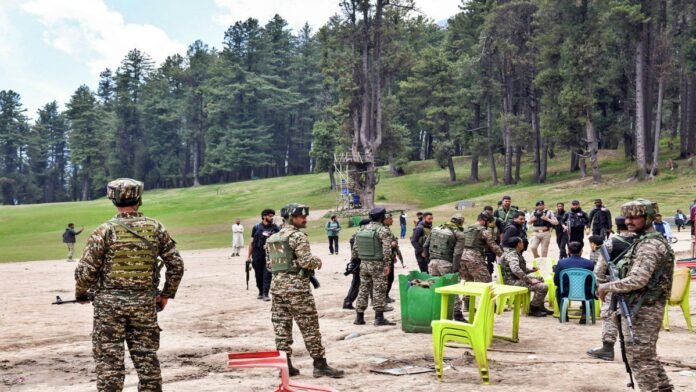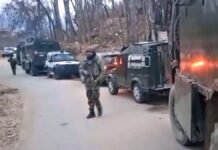
Key Points
- April 22 attack in Pahalgam killed 26 tourists, targeting victims based on religion.
- Intelligence and NIA reports confirm direct involvement of Pakistan’s political leadership, military, ISI, and Lashkar-e-Taiba in plotting the massacre.
- Attack executed on the lines of the 26/11 Mumbai terror attacks, by Pakistani operatives only no Kashmiri militants involved for secrecy.
- Operation led by ‘Suleman’, a suspected Pakistani Special Forces-trained commando, assisted by two other Pakistani nationals.
- Attackers infiltrated region in 2022 and remained underground until the strike.
- Two local residents, Parvez and Bashir, provided logistical support but denied knowledge of the attack plan.
- Around 60–68 foreign terrorists and a handful of local operatives remain active in Jammu and Kashmir, fueling further security concerns.
New Delhi: India’s worst attack on tourists in nearly two decades, the Pahalgam massacre of April 22, has now been unmistakably traced to Pakistan’s top military and political hierarchy, with intelligence and law enforcement reports confirming the bloody plot was orchestrated by the ISI and Lashkar-e-Taiba (LeT). Twenty-six innocent tourists most targeted after being forced to reveal their religion were brutally killed in a meticulously planned strike that echoes the tactics of the 2008 Mumbai attack.
How the Attack Was Orchestrated
- ISI’s Masterplan
Intelligence sources reveal the Inter-Services Intelligence (ISI) in Pakistan directly ordered Lashkar-e-Taiba’s commander Sajid Jutt to organize the attack using only foreign-trained militants, ensuring no Kashmiri operatives were in the loop for maximum secrecy. - Mumbai-Style Tactics
The modus operandi including the selection of foreigners, target-casing, and secrecy mirrored the 26/11 Mumbai attacks, with attackers specifically seeking out civilians and selecting victims based on religious identity. - Key Operatives
The operation was led by ‘Suleman’, believed to be a former Pakistani special forces commando who underwent training at LeT’s Muridke hub and infiltrated into Jammu and Kashmir in 2022. Two other Pakistani nationals, also LeT-trained, were part of the team. - Infiltration and Dormancy
Satellite phone tracking placed Suleman in the Tral forest one week before the massacre, confirming careful preparation and surveillance. He was earlier linked to a deadly 2023 attack on an Army convoy in Poonch that killed five soldiers, after which he disappeared from intelligence radars until resurfacing for the Pahalgam plot.
The Incident: Targeting Tourists in Baisaran
On April 22, the terrorists entered the popular Baisaran meadows near Pahalgam a zone just reopened to tourists. Dressed in Indian Army fatigues and using code names (Moosa, Yunus, Asif), they herded unarmed holidaymakers, demanded proof of religion, and opened indiscriminate fire on non-Muslims. With no local militants involved, the attackers relied on minimal information sharing and the element of surprise, exploiting the absence of security deployment in the area.
Police and NIA Investigation: Unmasking the Network
- Primary Suspects
J&K Police and the NIA identified the main perpetrators as Suleman, Asif Fauji (Moosa), and Abu Talha (Asif). - Supporting Roles
Two Pahalgam locals, Parvez Ahmed Jothar and Bashir Ahmed Jothar, were arrested for aiding the attackers with food and shelter at a seasonal hut in Hill Park. The NIA alleges they knowingly harboured the Pakistani gunmen, although both deny prior knowledge of the terror plot. - Lack of Local Facilitators
There is as yet no evidence that prominent local militant Adil Hussain Thoker or others were directly involved in planning or executing the attack.
Broader Implications and Security Response
- Scale of Threat
At least 60–68 foreign terrorists primarily from Pakistan remain at large in the Valley, along with a handful of local recruits aiding with logistics. - Strategic Fallout
The attack has prompted intensified military and intelligence operations, with Indian forces targeting terror camps in Pakistan and ramping up cross-border counter-infiltration drives. - International Repercussions
These developments have further strained India-Pakistan ties, with the international community watching closely for the next steps amid rising tensions.
Table: Key Figures Identified in the Pahalgam Attack
| Name | Affiliation | Nationality | Role/Status |
|---|---|---|---|
| Suleman (Hashmi Musa) | Lashkar-e-Taiba, ISI | Pakistani | Team leader, direct perpetrator |
| Asif Fauji (Moosa) | Lashkar-e-Taiba/TRF | Pakistani | Operations, field execution |
| Abu Talha (Asif) | Lashkar-e-Taiba/TRF | Pakistani | Operations, field execution |
| Parvez A. Jothar | Local resident | Indian | Logistical support, arrested |
| Bashir A. Jothar | Local resident | Indian | Logistical support, arrested |
The Pahalgam terror attack marks a chilling escalation of cross-border terrorism, with thorough intelligence and investigative findings establishing direct command and execution by Pakistan’s ISI and Lashkar-e-Taiba and no involvement by local militants in the plot. As Indian agencies continue to dismantle the support structures for such attacks, security in Jammu and Kashmir remains on high alert.
All facts and operational details reflect the current official investigations and reports as of July 15, 2025.





















































